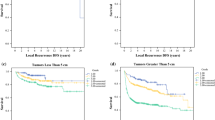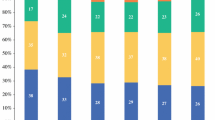Abstract
Introduction
The patterns of failure and mechanisms of sarcoma-specific death are poorly characterized among the minority of patients with low-grade soft tissue sarcoma (STS) who succumb to disease.
Methods
Between 1982 and 2006, 2,041 patients aged ≥16 years with low-grade STS of all sites were treated with curative intent and prospectively followed at a single institution.
Results
Among this cohort, 181 (9%) died from disease (DOD). Overall, 105 patients (58%) died from locally recurrent disease (DOLR), and 59 (32%) died from distant disease (DODR). In 17 patients (9%), the mechanism of sarcoma-related death could not be verified. DOD occurred at a median of 62 months, while median disease-specific survival for the entire cohort was not reached. Median follow-up was 66 months (range 2–431 months). On multivariate analysis, DOD was associated with site, size, and less than R0 resection. For DOLR, site, size, positive margins, liposarcoma histology, and local recurrence (by definition) were significant factors. For DODR, site, histology, and positive margins were not significant factors, while size and local recurrence were. Of DOLR, 80% were retroperitoneal, 68% were liposarcoma, and only 2% were extremity. Conversely, of DODR, extremity (47%) and trunk (18%) were the most common sites, but histology was more variable [liposarcoma 35%, malignant fibrous histiocytoma (MFH) 20%, fibrosarcoma 12%, extraskeletal myxoid chondrosarcoma 10%]. High-grade recurrence rates were comparable between DOLR (27%) and DODR (25%).
Conclusion
Among patients with low-grade STS, DOD occurs in approximately 9% of patients. Nonextremity site, larger size, and less than R0 resection are the most important risk factors for DOD, and distinct patterns of recurrence and death are predicted by primary tumor site.





Similar content being viewed by others
References
Hajdu SI, Shiu MH, Brennan MF. The role of the pathologist in the management of soft tissue sarcomas. World J Surg 1988; 12:326–31
Deyrup AT, Weiss SW. Grading of soft tissue sarcomas: the challenge of providing precise information in an imprecise world. Histopathology 2006; 48:42–50
Brennan MF, Singer S, Maki RG, et al. (2005) Sarcomas of the soft tissues and bone. In: DeVita V, Hellman S, Rosenberg S (eds.) Cancer: Principles and Practice of Oncology, 7th Edition. Lippincott, Williams, and Wilkins, pp 1581–637
Costa J, Wesley RA, Glatstein E et al. The grading of soft tissue sarcomas. Results of a clinicohistopathologic correlation in a series of 163 cases. Cancer 1984; 53:530–41
Trojani M, Contesso G, Coindre JM et al. Soft-tissue sarcomas of adults; study of pathological prognostic variables and definition of a histopathological grading system. Int J Cancer 1984; 33:37–42
Coindre JM, Terrier P, Guillou L et al. Predictive value of grade for metastasis development in the main histologic types of adult soft tissue sarcomas: a study of 1,240 patients from the French Federation of Cancer Centers Sarcoma Group. Cancer 2001; 91:1914–26
Coindre JM, Terrier P, Bui NB et al. Prognostic factors in adult patients with locally controlled soft tissue sarcoma. A study of 546 patients from the French Federation of Cancer Centers Sarcoma Group. J Clin Oncol 1996; 14:869–77
Gaynor JJ, Tan CC, Casper ES et al. Refinement of clinicopathologic staging for localized soft tissue sarcoma of the extremity: a study of 423 adults. J Clin Oncol 1992; 10:1317–29
Le Doussal V, Coindre JM, Leroux A et al. Prognostic factors for patients with localized primary malignant fibrous histiocytoma: a multicenter study of 216 patients with multivariate analysis. Cancer 1996; 77:1823–30
Pisters PW, Leung DH, Woodruff J et al. Analysis of prognostic factors in 1,041 patients with localized soft tissue sarcomas of the extremities. J Clin Oncol 1996; 14:1679–89
Zagars GK, Ballo MT, Pisters PW et al. Prognostic factors for patients with localized soft-tissue sarcoma treated with conservation surgery and radiation therapy: an analysis of 225 patients. Cancer 2003; 97:2530–43
Kattan MW, Leung DH, Brennan MF. Postoperative nomogram for 12-year sarcoma-specific death. J Clin Oncol 2002; 20:791–6
Marcus SG, Merino MJ, Glatstein E et al. Long-term outcome in 87 patients with low-grade soft-tissue sarcoma. Arch Surg 1993; 128:1336–43
Donohue JH, Collin C, Friedrich C et al. Low-grade soft tissue sarcomas of the extremities. Analysis of risk factors for metastasis. Cancer 1988; 62:184–93
Mariani L, Miceli R, Kattan MW et al. Validation and adaptation of a nomogram for predicting the survival of patients with extremity soft tissue sarcoma using a three-grade system. Cancer 2005; 103:402–8
Fletcher CD. The evolving classification of soft tissue tumours: an update based on the new WHO classification. Histopathology 2006; 48:3–12
Kooby DA, Antonescu CR, Brennan MF, et al. Atypical lipomatous tumor/well-differentiated liposarcoma of the extremity and trunk wall: importance of histological subtype with treatment recommendations. Ann Surg Oncol 2004; 11:78–84
Prentice RL, Kalbfleisch JD, Peterson AV Jr et al. The analysis of failure times in the presence of competing risks. Biometrics 1978; 34:541–54
Prentice RL, Kalbfleisch JD. Hazard rate models with covariates. Biometrics 1979; 35:25–39
Gray RJ. A class of K-sample tests for comparing the cumulative incidence of a competing risk. Ann Stat 1988; 16:1141–54
Fine JP, Gray JP. A proportional hazards model for the subdistribution of a competing risk. Jour Am Stat Assoc 1999; 94:496–509
Anderson JR, Cain KC, Gelber RD. Analysis of survival by tumor response. J Clin Oncol 1983; 1:710–9
Kandel RA, Bell RS, Wunder JS et al. Comparison between a 2- and 3-grade systems in predicting metastatic-free survival in extremity soft-tissue sarcoma. J Surg Oncol 1999; 72:77–82
Guillou L, Coindre JM, Bonichon F et al. Comparative study of the National Cancer Institute and French Federation of Cancer Centers Sarcoma Group grading systems in a population of 410 adult patients with soft tissue sarcoma. J Clin Oncol 1997; 15:350–62
Singer S, Corson JM, Gonin R et al. Prognostic factors predictive of survival and local recurrence for extremity soft tissue sarcoma. Ann Surg 1994; 219:165–73
Koea JB, Leung D, Lewis JJ et al. Histopathologic type: an independent prognostic factor in primary soft tissue sarcoma of the extremity? Ann Surg Oncol 2003; 10:432–40
Dunn GP, Ikeda H, Bruce AT et al. Interferon-gamma and cancer immunoediting. Immunol Res 2005; 32:231–45
Dunn GP, Bruce AT, Ikeda H et al. Cancer immunoediting: from immunosurveillance to tumor escape. Nat Immunol 2002; 3:991–8
Stojadinovic A, Leung DH, Hoos A et al. Analysis of the prognostic significance of microscopic margins in 2,084 localized primary adult soft tissue sarcomas. Ann Surg 2002; 235:424–34
Acknowledgements
This work was supported by Soft Tissue Sarcoma Program Project grant P01 CA 047179 (L.X.Q., R.G.M., S.S., and M.F.B.)
Author information
Authors and Affiliations
Corresponding author
Rights and permissions
About this article
Cite this article
Canter, R.J., Qin, LX., Ferrone, C.R. et al. Why Do Patients with Low-Grade Soft Tissue Sarcoma Die?. Ann Surg Oncol 15, 3550–3560 (2008). https://doi.org/10.1245/s10434-008-0163-0
Received:
Revised:
Accepted:
Published:
Issue Date:
DOI: https://doi.org/10.1245/s10434-008-0163-0




